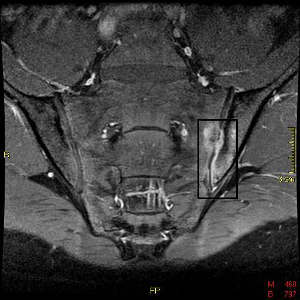Ankylosing Spondylitis

Ankylosing spondylitis (AS) is an inflammatory arthritis of the axial skeleton that predominantly affects young men. Although primarily affecting the spine, other joints can become involved. It causes inflammation of the vertebrae that can lead to severe pain and discomfort. In more advanced cases this inflammation can lead to ankylosis - new bone formation in the spine causing sections of the spine to fuse in a fixed, immobile position. AS can also affect other areas of the body such as the shoulders, hips, ribs, heels, and small joints of the hands and feet. Sometimes the eyes can become involved (known as iritis or uveitis) (1).
There is a strong genetic association, with MHC class I allele HLA-B*27 conferring the greatest genetic risk. However, genome-wide association studies have revealed more than 60 additional risk factors, including IL-23R and ERAP1 (endoplasmic reticulum aminopeptidase 1) amongst the most studied. A large proportion of these risk variants have also been found to be associated with related sero-negative diseases such as IBD and psoriasis, which may imply common mechanisms for underlying pathology. Indeed, up to 60% of AS patients are diagnosed with IBD (2).
- Jethwa, H., and Bowness, P. (2016) The interleukin (IL)-23/IL-17 axis in ankylosing spondylitis: new advances and potentials for treatment, Clin. Exp. Immunol. 183, 30-36.
- Ranganathan, V., Gracey, E., Brown, M. A., Inman, R. D., and Haroon, N. (2017) Pathogenesis of ankylosing spondylitis - recent advances and future directions, Nat Rev Rheumatol 13, 359-367.



